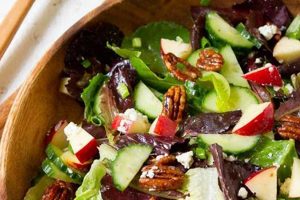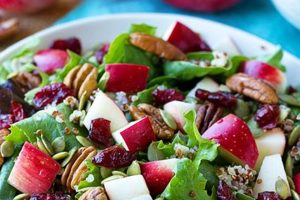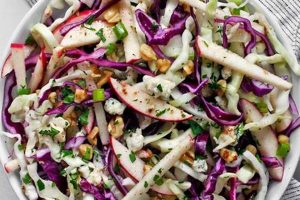Combinations of leafy greens, other fruits and vegetables, and a dressing often feature this fruit as a key ingredient, providing sweetness and texture. A simple example includes spinach, sliced apples, crumbled goat cheese, candied pecans, and a light vinaigrette.
Apple inclusion contributes nutritional value, offering fiber, vitamins, and antioxidants. The fruit’s versatility allows for diverse flavor profiles, ranging from sweet and tart to savory, depending on the chosen variety and accompanying ingredients. Historically, apples have been a readily available and affordable ingredient, making them a popular choice in various culinary traditions.
Exploration of specific apple varieties best suited for salads, complementary ingredients, and dressing options will further illuminate the potential of incorporating this versatile fruit into fresh and flavorful dishes. Considerations for balancing textures and flavors, along with tips for preparation and presentation, will also be addressed.
Tips for Apple Salad Preparation
Optimal preparation techniques enhance the flavor and texture of salads featuring this popular fruit. Attention to detail ensures a delightful culinary experience.
Tip 1: Apple Selection Variety selection significantly impacts the final dish. Honeycrisp offers sweetness and crispness, while Granny Smith provides tartness. Consider the desired flavor profile when choosing.
Tip 2: Preventing Browning To maintain visual appeal, prevent enzymatic browning by coating sliced apples with a mixture of lemon juice and water. This maintains the fruit’s fresh appearance.
Tip 3: Balancing Flavors Balance sweetness with contrasting elements. Pair sweet apples with tangy cheeses, bitter greens, or savory nuts. Consider a vinaigrette with acidity to cut through richness.
Tip 4: Texture Considerations Vary textures for an engaging sensory experience. Combine crisp apples with creamy cheeses, crunchy nuts, and tender greens. This contrast enhances enjoyment.
Tip 5: Dressing Application Dress salads just before serving to prevent the greens from wilting. Lightly coat ingredients to ensure even flavor distribution and avoid sogginess.
Tip 6: Ingredient Incorporation Incorporate the fruit strategically. For salads with delicate greens, add sliced apples closer to serving time to prevent bruising. For heartier salads, incorporate earlier.
Tip 7: Seasonal Considerations Utilize seasonal ingredients to maximize flavor. Pair apples with autumnal vegetables like roasted squash or winter greens like kale. This enhances the dish’s overall character.
Careful selection, preparation, and thoughtful combination of ingredients elevate dishes featuring this versatile fruit from simple to extraordinary.
By following these guidelines, culinary enthusiasts can consistently create flavorful and visually appealing salads that showcase the unique qualities of apples.
1. Apple Variety
Apple variety selection significantly influences the overall flavor profile and textural complexity of a salad. The inherent sweetness, tartness, and firmness of the apple interact with other ingredients, impacting the final culinary experience. Understanding these nuances allows for informed decision-making when crafting a balanced and flavorful salad.
- Sweetness
Sweeter varieties, such as Fuji, Gala, or Honeycrisp, contribute a pronounced sweetness to the salad. These apples often pair well with bolder flavors like sharp cheeses, pecans, and slightly acidic dressings. The inherent sweetness can balance savory elements, creating a harmonious blend.
- Tartness
Tart apples, like Granny Smith or Braeburn, offer a refreshing acidity that contrasts with richer ingredients. They provide a bright counterpoint to creamy cheeses, nuts, and dried fruits. Their crisp texture also adds a desirable crunch.
- Texture
Apple texture, ranging from crisp to tender, plays a crucial role in the overall mouthfeel of the salad. Crisp apples, like Pink Lady, maintain their structure and provide a satisfying bite, while softer varieties, like McIntosh, offer a more delicate texture. The chosen texture should complement the other ingredients.
- Flavor Complexity
Certain varieties, like Honeycrisp, possess a complex flavor profile with notes of honey and pear, adding depth to the salad. Others, like Red Delicious, offer a more straightforward sweetness. This complexity can enhance or detract from the overall composition, depending on the desired outcome.
Consideration of these facets of apple variety ensures a well-balanced and flavorful salad. Strategic pairing of apple characteristics with complementary ingredients and dressings elevates the dish, transforming simple components into a harmonious culinary creation. Careful selection ultimately dictates the success of the salad.
2. Complementary Ingredients
Ingredient selection significantly impacts the overall balance and complexity of apple-based salads. Careful consideration of flavor profiles, textures, and nutritional value enhances the final dish. Complementary ingredients interact with the apple’s inherent sweetness, tartness, and texture, creating a harmonious blend of flavors and a satisfying sensory experience. The interplay of these elements elevates the salad beyond a simple combination of ingredients.
Several categories of complementary ingredients enhance apple salads. Cheese selection provides an opportunity to introduce contrasting or supporting flavors. Sharp cheddar enhances the sweetness of Honeycrisp apples, while creamy goat cheese complements the tartness of Granny Smith. Nuts, such as walnuts or pecans, contribute textural contrast and richness. Dried cranberries or raisins offer concentrated sweetness and chewiness. Leafy greens, like spinach or arugula, provide a foundational base and contribute vitamins and minerals. Proteins, such as grilled chicken or chickpeas, transform the salad into a complete meal.
Practical application of these principles requires an understanding of flavor pairings and textural interplay. A successful salad balances the sweetness of the apple with contrasting elements, such as tangy cheeses, bitter greens, or savory nuts. Textural variety, achieved through the incorporation of crunchy nuts, creamy cheeses, and crisp apples, enhances the dining experience. Nutritional considerations also play a role. Adding protein and a variety of vegetables elevates the salad’s nutritional value. Ultimately, thoughtful ingredient selection transforms a basic apple salad into a well-balanced and satisfying dish.
3. Dressing Choice
Dressing selection significantly impacts the overall flavor profile and balance of apple-based salads. The dressing should complement, not overpower, the inherent sweetness, tartness, and texture of the apple and other ingredients. Careful consideration of flavor pairings and acidity levels ensures a harmonious blend of tastes and a pleasant sensory experience. An appropriate dressing enhances the interplay of ingredients, transforming individual components into a cohesive culinary creation.
Several factors influence dressing choice. Apple variety plays a crucial role. A sweet apple, like Honeycrisp, pairs well with a tangy vinaigrette, while a tart Granny Smith benefits from a creamy, slightly sweet dressing. The presence of other ingredients, such as cheese and nuts, also influences dressing selection. A salad with strong cheeses, like blue cheese or Roquefort, might require a lighter vinaigrette, while a salad with milder cheeses, like goat cheese, could benefit from a richer, more flavorful dressing. Desired flavor outcomes also guide dressing selection. A light and refreshing salad might call for a citrus-based vinaigrette, while a more substantial salad might benefit from a creamy dressing with herbs and spices. Practical examples include pairing a balsamic vinaigrette with a salad featuring Granny Smith apples, walnuts, and gorgonzola cheese, or using a honey-mustard dressing with a salad containing Honeycrisp apples, pecans, and feta cheese. These pairings illustrate the interplay between dressing and ingredients in achieving a balanced and flavorful salad.
Understanding the nuanced relationship between dressing choice and salad composition elevates the culinary experience. Achieving a harmonious balance of flavors requires careful consideration of apple variety, complementary ingredients, and desired flavor outcomes. Appropriate dressing selection enhances the interplay of flavors and textures, transforming individual components into a cohesive and satisfying dish. By recognizing the significance of dressing choice, culinary enthusiasts can create apple-based salads that are both flavorful and balanced.
4. Preparation Techniques
Preparation techniques significantly influence the final quality and appeal of salads incorporating apples. Proper handling and processing methods ensure optimal flavor, texture, and presentation, maximizing the enjoyment of the dish. These techniques address considerations such as preventing oxidation, enhancing textural contrast, and optimizing ingredient integration.
- Slicing and Chopping
Apple slicing methods impact both visual appeal and texture. Thinly sliced apples offer a delicate texture and integrate seamlessly with other ingredients, while thicker slices or chunks provide a more substantial bite. Uniformity in size ensures even distribution of flavor and a visually appealing presentation. Dicing apples creates smaller pieces suitable for incorporating throughout the salad, while matchsticks offer a more elegant presentation.
- Preventing Oxidation
Exposure to air causes enzymatic browning in apples, impacting their visual appeal. Preventing this oxidation requires techniques like coating cut surfaces with an acidic solution, such as lemon juice or ascorbic acid. This process inhibits the enzymatic reaction responsible for browning, maintaining the apple’s fresh appearance and preventing discoloration. Prompt incorporation into the salad after cutting also minimizes oxidation.
- Macerating
Macerating apples in a flavorful liquid, such as fruit juice, liqueur, or a spiced syrup, infuses them with additional flavor and can alter their texture. This technique enhances the apple’s sweetness and complexity, complementing other salad ingredients. Maceration times vary depending on the desired intensity of flavor and texture modification. The liquid used for maceration can also contribute to the overall flavor profile of the salad dressing.
- Pre-cooking
Pre-cooking apples through methods like grilling, sauting, or roasting introduces new flavor dimensions and textural complexities. Grilling imparts a smoky char, while sauting caramelizes the apple’s natural sugars, enhancing sweetness. Roasting concentrates flavors and softens the apple’s texture. Pre-cooked apples offer a unique contrast to fresh ingredients in the salad, adding depth and complexity.
These preparation techniques offer a range of options for enhancing apple salads. Strategic application of these methods allows for customization of flavor, texture, and presentation, elevating the dish beyond a simple combination of ingredients. By understanding and utilizing these techniques, culinary enthusiasts can create apple salads that are both visually appealing and flavorful.
5. Presentation
Presentation significantly impacts the perceived quality and enjoyment of apple-based salads. Visual appeal enhances the dining experience, influencing perceptions of flavor and freshness. Strategic arrangement of ingredients and thoughtful use of color and texture create a more enticing and appetizing presentation. This attention to detail elevates the salad from a simple dish to a culinary creation.
Several factors contribute to effective salad presentation. Color contrast creates visual interest. The vibrant green of spinach, the deep red of radicchio, and the bright hues of apple slices create a visually dynamic composition. Textural variation further enhances appeal. Crisp apple slices alongside creamy goat cheese, crunchy walnuts, and delicate greens offer a multi-sensory experience. Height and layering add dimension to the salad, preventing a flat, uninspired appearance. Mounding ingredients in the center or strategically placing larger elements creates visual depth. Plate selection also plays a role. A white plate provides a neutral backdrop that accentuates the colors of the salad ingredients, while a patterned plate can complement or contrast with the salad’s composition. Garnishes, such as a sprinkle of chopped herbs or a drizzle of dressing, provide finishing touches that enhance visual appeal.
Practical application of these principles involves considering the interplay of colors, textures, and shapes. Arranging apple slices artfully alongside complementary ingredients creates a visually balanced presentation. Utilizing appropriate serving vessels and garnishes adds a touch of elegance. Ultimately, thoughtful presentation elevates the dining experience, transforming a simple apple salad into a visually appealing and appetizing culinary creation. This attention to detail demonstrates care and consideration, enhancing enjoyment and appreciation of the dish.
Frequently Asked Questions
This section addresses common inquiries regarding the incorporation of apples into salads, offering practical guidance and clarifying potential uncertainties. These responses aim to provide comprehensive information for optimizing salad preparation and maximizing enjoyment.
Question 1: How can enzymatic browning in apples be prevented after slicing?
Coating sliced apples with an acidic solution, such as lemon juice diluted with water, inhibits oxidation and maintains the fruit’s fresh appearance. Prompt incorporation into the salad after slicing also minimizes exposure to air.
Question 2: Which apple varieties are best suited for salads?
Variety selection depends on the desired flavor profile. Honeycrisp or Fuji apples offer sweetness, while Granny Smith or Braeburn provide tartness. Consider the interplay of flavors with other salad components.
Question 3: What complementary ingredients pair well with apples in salads?
Nuts, cheeses, and dried fruits complement apples well. Walnuts, pecans, and almonds provide textural contrast, while cheeses like cheddar, goat cheese, and blue cheese offer varying flavor profiles. Dried cranberries or raisins add sweetness and chewiness. Leafy greens like spinach or arugula provide a foundational base.
Question 4: What dressings are recommended for apple salads?
Vinaigrettes with acidity balance the sweetness of apples. Balsamic, citrus, or apple cider vinaigrettes are suitable choices. Creamy dressings, such as honey-mustard or poppy seed, can also complement certain apple varieties and ingredient combinations.
Question 5: How can apple salads be made more substantial as a main course?
Adding protein, such as grilled chicken, shrimp, or chickpeas, transforms a side salad into a complete meal. Incorporating grains, like quinoa or farro, further enhances satiety and nutritional value.
Question 6: How should an apple salad be stored to maintain freshness?
Store prepared apple salad components separately and combine just before serving to maintain optimal texture and prevent sogginess. Store dressed salads in airtight containers in refrigeration for short periods, but note that some textural changes may occur.
Careful consideration of these points ensures optimal preparation and enjoyment of salads featuring apples.
Further exploration of specific recipes and variations can expand culinary horizons.
Conclusion
Exploration of flavorful and nutritious salad recipes incorporating apples reveals the fruit’s culinary versatility. Careful selection of apple varieties, complementary ingredients, and dressings allows for a diverse range of flavor profiles, from sweet and tangy to savory and complex. Proper preparation techniques, including preventing oxidation and balancing textures, ensure optimal enjoyment. Presentation considerations further enhance the dining experience.
The adaptability of apples within the culinary landscape underscores their value as a key ingredient in salads. Continued exploration of flavor combinations and innovative preparation methods promises further expansion of culinary possibilities, encouraging creativity and enjoyment in the kitchen.






